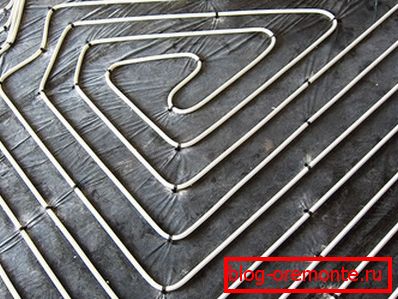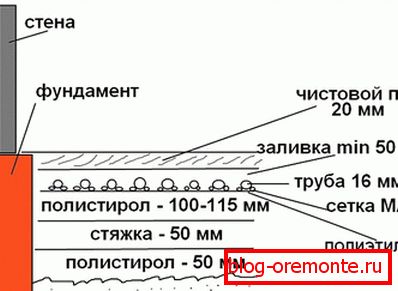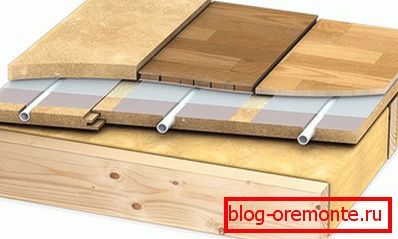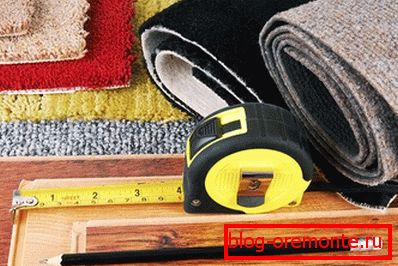Which floor is better - water or electric
Heated floors have two purposes, they can replace the usual radiator system or serve as an additional source of heat. But, before embarking on the implementation of such a heating system, you should decide on which floor heating is better - water or electric. This is important, because not all cases, you can use electric or water floor heating. This article will highlight the advantages and disadvantages of each system, as well as the features of their implementation.
Types of warm floors

There are two main types of floor heating:
- Electric.
- Water.
They differ in the type of heating element as well as the method of transfer of thermal energy. For example, water is used as a heat carrier for a heated floor. It is heated by a gas or electric boiler. The coolant is distributed through the heating pipes, which are formed in separate circuits. As for the electric floor heating, its coolant is electricity. On the modern market are such varieties of warm electric floors:
- Cable.
- Electric mats.
- Infrared film.

The current flowing through electrical wires is converted into thermal energy, which heats the floor. The differences between these systems are in the method of their installation and combination with one or another floor material.
Features of water floor heating

Although installing a heated floor is not easy, the result is worth it. Heat energy will be evenly distributed over the entire floor surface. If this system is used as the main one, then the cost of its operation will be minimal.
The first step is to remove the old flooring. If it is concrete, then physical force will be required. The surface must be cleaned to the subfloor.
The very same construction of a water heated floor has a fairly large cake. It includes:
- waterproofing layer;
- heat insulation layer;
- reinforcing mesh;
- pipes;
- layer of finishing screed;
- finishing flooring.
Note! Removing the old coating to the draft of the screed, due to several required layers for laying water floor.

The design of a warm water floor can be from 5 to 7 cm thick. Plus, it is necessary to take into account the heat insulation layer, which, depending on the type of insulation, can be 4–15 cm thick. As a result, the resulting structure will have a lot of weight.
Note! A large weight of a warm water floor can become an obstacle for its organization in an apartment in a high-rise building. Especially if the house is old and has hardwood floors.
The apartments mainly connected central heating. Therefore, to organize a heated floor will require a number of permits or the transfer of all residents to this type of heating. In most cases, it is not possible to reach a general consensus on this issue with the neighbors.
As can be seen with all the advantages, warm water floors have their limitations. As for private houses, in this case a warm floor in 99% is possible and even justified.
Features of electric heating devices

Thermal energy in electric heating is transferred to the flooring. On the one hand, this is good, on the other - bad. Why? The surface of the floor with electric heating is always the same. This may seem good. But, it imposes some restrictions on the implementation of electric heating in combination with a number of floor materials and even the arrangement of furniture.
As mentioned at the beginning of the article, electric heating is divided into film and cable form. Cable heating is mounted exclusively on the body of the tie and in no way affects its thickness (in the case of a water system, the picture is completely opposite). As for the film floor, it goes directly to the finishing screed. It is necessary to lay a heat-insulating layer under it, which should have a foiled surface.
Note! The use of electric heating allows you to quickly and efficiently heat small rooms, such as open areas, attic, balconies, loggias and more.

The choice of one or another type of electric heating will depend on the method and purpose of its use. So, there is a variant of its combination with the main radiator heating. This is especially true in apartments, when central heating is not yet included, and it is already cold in the living rooms. In this situation, a warm electric floor will help maintain health.
What to choose as an additional source of heat?

If the heated floor is intended as an additional source of heat, then it is required to evenly and slightly heat the surface. In most cases this is true, for example, on a loggia or bathroom. What is better to choose in this case? Here, electric heating has no equal. Only it can evenly distribute heat over the desired surface. It uses a thermostat that keeps the temperature at a given level. The water system is much inferior in this situation. Since during the passage of the coolant through the pipes, its temperature drops. As a result, it is difficult to achieve uniform heating.
Note! In practice, there are systems and methods of laying pipes that allow to achieve uniform heating of the floor surface. But, if an additional source of heat is needed, then electrical construction is much easier and faster.
What to choose for the main heating?

In favor of warm floors, you can completely abandon the traditional radiator heating. In this case, the hydraulic system will be the best solution. The main requirement is to warm the living area to t = 20-24 ° C.
Note! When creating a water heated floor as the main source of heat, it is necessary to make accurate calculations of heat loss through the ceiling, windows and external walls.
For this task, heat heating is not suitable. As it is known, it is impossible to put it under household appliances, sanitary appliances and furniture. Therefore, in these areas a temperature imbalance with the cold bridge will be formed. This will be an additional source of heat loss.
Note! If the water heating pipes are correctly positioned, then near the external walls heat loss can be minimized and the heat transfer to the center of the room can be reduced to a minimum, since excessive heating will be inappropriate.
Application of warm floor, исходя от помещения

From all of the above, it becomes clear that each type of heating has its advantages in certain circumstances. So, each of the systems is relevant in the following situations:
Electric heating:
- As an additional source of heat for the attic, veranda, loggia, bathroom, etc.
- To quickly achieve the required temperature in the bathroom and bathroom for a short time.
- Relevant in cases where the water floor is impossible to implement, for example, high-rise buildings.
- If you can not dismantle the floor covering, apply film electric heating.
Water heating:
- Ideal for the main heating of the living space.
- If it is permissible, they are installed as an addition to the existing radiator system in the apartment or private house.
For which flooring materials laying of the floor is impossible?

There are some restrictions on combining underfloor heating with floor materials. If the finishing floor material has a large layer of thermal insulation, this will interfere with the good heat flow into the room from the pipe. So, ceramic tile is an excellent conductor of thermal energy. If we compare tiles with carpet, parquet or linoleum, then these materials have a lower thermal conductivity. Through them the heat will be much slower. As a consequence, more energy will be required for the coolant. Moreover, the heating elements either electric or water will overheat greatly, which will affect their operational life.
If you lay parquet on top of a warm floor, then the constant high temperatures of the heat carrier will dry out the floor covering, which will negatively affect its appearance. From this it becomes clear that you can not combine floor heating with every floor material.
What kind of flooring can I heat?

There are a number of finishing flooring materials that are ideally combined with floor heating. These include:
- Thin floorboard.
- Laminate.
- Non-insulated linoleum.
- Ceramic / tile.
- Self-leveling floors.
Note! The combination of a warm floor system with a tile and a self-leveling floor is considered the best. These materials very quickly transfer thermal energy and do not delay it in any way. Accordingly, heat losses are minimized.
For the water system, all of the above materials are ideal. Moreover, it can be combined with natural parquet. This is due to the gradual heating, which provides a water circuit. The heat carrier gradually gains the set temperature. Accordingly, the heat is distributed evenly over the entire floor area.

In this case, electric heating has its own characteristics. For its combination with tile / ceramic tile, only cable floor can be used. Only this system can be poured with a coupler. If it is necessary to create an additional source of heat without overhauling the screed, the infrared film floor is the ideal solution. It can be laid directly under the laminate or linoleum. Mounting of the infrared film is carried out between two layers of a shock absorbing heat insulator (polyethylene foam). With this design, thermal energy will not be expended on heating the thickness of the screed, but will immediately enter the room.
What is more economical and warms better?

Definitely say what is best is impossible. Each type of heating, both water and electric, perfectly cope with its main task, provided proper installation. If you have a limited budget, you can choose an electric method of floor heating. However, every month you will receive large bills to pay for electricity. On the other hand, the water heating method will immediately require large investments in installation work. But, from an economic point of view in the future, this kind of heat is less expensive. On the other hand, it makes no sense to construct a water floor on a balcony or a loggia, here electric heating is better suited.
On this topic, you can discuss for hours. We suggest you leave feedback at the end of this article. Especially if you have already made a floor heating system. Perhaps you have your own opinion about the question, which is better to give your preference - water or electric heating system.
Video
Learn from the video about the features of electric and heated floors.